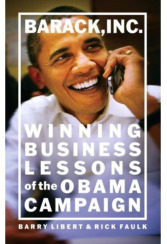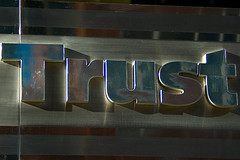|
|
|
Archive for the 'Leadership Resources' Category
Tuesday, March 31st, 2009
 I’m a simplifier; more than that I really dislike complexifiers, but, sadly, their numbers seem to be increasing daily. I’m a simplifier; more than that I really dislike complexifiers, but, sadly, their numbers seem to be increasing daily.
In work situations especially adding complexity is a way to demotivate the people around you (above, beside and below) and set everyone up to fail.
Sometimes what sounds like complexifying turns out to be just poor communications once you sort your way through what was said.
But there are a number of folks out there who honestly believe that complex equals smart and simple equals dumb. If that’s the case give me dumb every time.
Complexification isn’t a minor problem and often leads to major difficulties—think complex products like derivatives, Windows, phone menus in which you can get lost for days, low productivity, poor morale—the list is endless.
Here are four ways to know if you’re a complexifier
- Are you met with blank looks when you describe something?
- Is “huh” a typical response to what you say?
- Do you frequently have to repeat what you say?
- Are you constantly asked to explain what you mean?
And here’s what to do if you find you are one
- First decide whether it’s what you mean or how you think.
- If the problem is how you say it, i.e., the communications, take advantage of this post and if you want more help give me a call me at 866.265.7267.
- If it’s how you think then you need to look at your MAP (mindset, attitude, philosophy™) and identify why you prefer difficult/complicated/elaborate/intricate/convoluted/confusing
- Changing MAP is a process that requires developing a special type of awareness
The great thing is that it’s always your choice.
Now a quick note about simplifying.
Brian R Nichols passed on a great idea in his comment on last week’s Ducks In A Row: A Tool To Make Reviews And Management Easier.
Here it is in Brian’s own words.
“The GSA looks like a good simple tool that I’ll have to try. Another simple tool I got from one of my former bosses is what he called a significant events log. It is basically a diary for each subordinate kept in an Excel worksheet. Both positive and negative comments are entered as warranted. It helps funnel the entire year into the review, not just the successes or failures of the moment.”
Call it an SEL Funnel; it will make your ongoing feedback and reviews even simpler while preventing selective memory from rearing its ugly head.
Your comments—priceless
Don’t miss a post, subscribe via RSS or EMAIL
Image credit: flickr
Posted in About Leadership, Communication, Culture, Ducks In A Row, Leadership Resources, management, Personal Development, What Leaders DON'T | 4 Comments »
Monday, March 30th, 2009
 One of the hardest things that growing companies face is the need to stop shooting from the hip. One of the hardest things that growing companies face is the need to stop shooting from the hip.
I hear the reasons not to all the time, from startups, small biz, entrepreneurs, et al:
- It will ruin our culture.
- It stifles creativity. It’s for larger companies.
- It’s bureaucratic. It’s too time consuming.
“It” refers to the underpinnings of all successful companies. “It” includes the following in order of importance:
- Financial controls that include
- monthly statements of revenues by product;
- discounts;
- costs by department;
- cost of goods sold;
- inventory;
- receivables aging;
- stock issuance;
- cash flow;
- manufacturing yields;
- hiring by department
- Annual operating plan covering the above financial measures
- Organization charts and definitions of responsibilities
- Hiring process
- Long-term planning
- Centralized information technology implementation and planning
Whether it’s just you, or one, ten, fifty, or more employees, whether full time, part time or virtual, you need viable processes to keep you focused—think of it as coloring inside the lines.
Everything on this list can, and should, be scaled for applicability, but all are important to every business endeavor.
Those that don’t directly apply may be tweaked, e.g., manufacturing yields can change to productivity measures; a very few, such as “stock issuance” may be completely discarded if the action is truly warranted.
Sure, they can’t all be implemented at once, but none of them will happen as long as your MAP rejects or begrudges them—after all, you’re the boss (CEO/president/managing partner/owner) and people will follow your lead.
Finally, don’t confuse process with bureaucracy. Process is like MAP, it gets you where you want to go, whereas bureaucracy stifles whatever it touches; process, like MAP, is ever-growing, while bureaucracy is carved in stone.
Your comments—priceless
Don’t miss a post, subscribe via RSS or EMAIL
Image credit: flickr
Posted in About Leadership, Culture, Entrepreneurship, Innovation, Leadership Resources, Leadership Skills, management, What Leaders DO | 3 Comments »
Saturday, March 21st, 2009
 Usually I only offer up one link when the reading is heavy, but today I have two. Usually I only offer up one link when the reading is heavy, but today I have two.
The first is a book I read about on Expert CEO.
How We Decide by Jonah Lehrer is an exploration of “the neural machinery behind our decision-making processes: a network of dopamine-sensitive cells in the brain’s emotional and cognitive centers, which tie feelings and reason together so closely that the two operate almost as one. According to Lehrer, correct decisions require an awareness of both halves of the equation — and a perfect balance of visceral response and cognitive knowledge.”
I’m so far behind on my reading that I don’t know when I’ll get to it, but if one of you wants to do a guest review for Leadership Turn I’d be delighted.
The heavy reading comes from Max Bazerman, the Jesse Isidor Straus Professor of Business Administration at Harvard Business School. A working paper “shows that seemingly innocuous aspects of the environment can promote the decision to act ethically or unethically. Key concepts include:
- Once people behave dishonestly, they are able to morally disengage, setting off a downward spiral of future bad behavior and ever more lenient moral codes.
- However, this slippery slope can be forestalled with simple measures, such as honor codes, that increase people’s awareness of ethical standards.
- Moral disengagement is not always a necessary condition leading to dishonesty, but it may in fact result from unethical behavior.
- The decision to behave dishonestly changes levels of moral disengagement, and the awareness of ethical standards affects the decision to engage in unethical behavior.”
The paper is downloadable and I think you’ll find it interesting.
As always, your thoughts on the subject are of great interest, so please share them.
Your comments—priceless
Don’t miss a post, subscribe via RSS or EMAIL
Image credit: flickr
Posted in About Leadership, Leadership Resources, Leadership Skills, management, Personal Development, Seize Your Leadership Day, What Do You Think? | 2 Comments »
Saturday, March 7th, 2009
 I was delighted when I was sent a free copy of Barack, Inc.: Winning Business Lessons of I was delighted when I was sent a free copy of Barack, Inc.: Winning Business Lessons of  the Obama Campaign to review. Not just because I voted for him, but because this is a book about how to sell change, major change, to strangers and in doing so turn them into a community of supporters. the Obama Campaign to review. Not just because I voted for him, but because this is a book about how to sell change, major change, to strangers and in doing so turn them into a community of supporters.
That’s what Apple did with the iPod and that’s what every CEO recognizes as being of paramount importance.
In a post last summer I said, “You must constantly change MAP (mindset, attitude, philosophy™)—your own, your people’s and your culture’s.
But it’s not just about managing change; it’s about creating a desire for it. It’s about creating an environment where changes are being driven by your workers, not just by you and your execs.”
That’s what Obama and his team did brilliantly and that’s why you should read the book.
Forget politics, think about the challenges your company faces. Survival isn’t enough.
The business world and consumer landscapes are changing—industries that downplay or ignore innovation to focus on survival and the status quo out of fear of upsetting their current business model are likely to be swept away by the transformation rocking the global economy.
To thrive, you need to engage your current stakeholders (investors, employees, vendors, current customers)—just as Obama did.
His success turned on three main points, he
- kept his cool under all provocations,
- applied social technologies, including blogs, texting, and viral videos, and
- made himself synonymous with what he was selling—change.
Obama allowed nothing to be set in stone and moved swiftly when the landscape changed.
One of my favorite examples was his choice to reject funding limitations, although he had previously said he would accept them. Why?
Because he realized that the amount of money he would raise via the Net more than compensated for McCain’s bashing him for the switch.
Now substitute ‘innovation’ for money and ‘quarterly results’ for bashing and give it some hard thought.
Read the book; adopt/tweak/adjust its lessons and tools for your company’s situation and then execute, because all the theory and examples won’t help unless you have the courage to use them.
Your comments—priceless
Don’t miss a post, subscribe via RSS or EMAIL
Image credit: flickr and Amazon
Posted in About Leadership, Change, Communication, Culture, Group Dynamics, Innovation, Leaders Who DO, Leadership Resources, Leadership Skills, Leading Factors, management, Personal Development, Politics, Reviews & Recommendations, Seize Your Leadership Day | No Comments »
Monday, February 9th, 2009
Last week I wrote about both the need and approaches for management to communicate bad news openly and honestly. Wes Ball commented on the need to keep employees involved, which is what I was planning to talk about today.
The language of employee involvement keeps changing, so if you want to do more research, “engage,” in its many forms, seems to be the term of choice for now.
There are five basic rules that must be followed when your focus is to create, enhance or increase engagement.
 Rule One: Engagement is based on trust. If employees don’t trust their management then management can forget about engaging its employees. Rule One: Engagement is based on trust. If employees don’t trust their management then management can forget about engaging its employees.
Rule Two: Engagement requires involvement. Asking for employee input after the decision(s) are already made is a con and breaks trust.
Rule Three: Engagement is based on fairness. Treating a select minority as royalty and the rest like replaceable dirt disengages everyone (including the royalty) and breaks trust.
Rule Four: Engagement requires management to make its decisions first for the sake of the company, second for the sake of the group and third for the sake of themselves. Done in any other order break trust.
Rule Five: Engagement requires courage, authenticity and genuineness (see Notes). Any form of lie/cheat/steal/trash breaks trust.
And while Rule One is the primary rule it is also the corollary of the other four.
Engaging your people, whatever your level of management, starts in your MAP (mindset, attitude, philosophy™).
No matter how well taught, implementing the mechanics of engagement can proceed no further than your belief in, and adherence to, the five rules.
If your MAP acknowledges a need to break the rules don’t waste your time on engagement efforts, because they are doomed to fail. That energy would be better used on recruitment, since your attrition rate will be far higher than any layoff could account for.
NOTE: Two of the best sources on engagement mechanics are Steve Roseler and David Zinger.
Your comments—priceless
Don’t miss a post, subscribe via RSS or EMAIL
Image credit: flickr
Posted in About Leadership, Communication, Culture, Entrepreneurship, Leadership Resources, management, Personal Development, What Leaders DO | 10 Comments »
Saturday, February 7th, 2009
 Although I read a lot of article and blogs, I’m very particular about what I pass on to you. I often link to a particular post, but have a much more limited list to share when people write and ask what to read daily when they have very limited time. Although I read a lot of article and blogs, I’m very particular about what I pass on to you. I often link to a particular post, but have a much more limited list to share when people write and ask what to read daily when they have very limited time.
I find the topics relevant, but there are a multitude of similar topics every day, so what sets the ones I choose apart? Synergistic MAP and the writing.
I admit that I’m a writing snob. Quantity doesn’t equal quality; reading through dense prose bores me, so the ones I like are clearly and concisely written. This doesn’t mean other don’t have merit, it just means that they don’t do it for me.
The point being that you need to find sources that resonate and work for you, not for whoever recommends it.
That said, here are my four favorites.
Jim Stroup is responsible for Managing Leadership. Jim is who you read when you want to stimulate your brain and dig into the philosophical, strategic and tactical ramifications of business and politics. He’s also one of the most charismatic, brilliant writers I’ve found.
Steve Roesler writes All Things Workplace. Steve draws his topics from the situations he deals with every day in his work. His advice is practical, down-to-earth, common sense-based and, most importantly, immediately useable.
Phil Gerbyshak over at Slacker Manager is the guy for whom everyone wants to work. He provides great input, especially for less experienced managers—although I know a lot of executives who could benefit by following it.
Mark Jabo at Biz Levity fills my laugh bucket and helps me keep my perspective. His posts are my way of remembering that in the great scheme of things none of this really matters—except to the archeologists when they dig though our digital trash.
Your comments—priceless
Don’t miss a post, subscribe via RSS or EMAIL
Image credit: flickr
Posted in About Leadership, Leadership Resources, management, Seize Your Leadership Day, What Leaders DO | No Comments »
Friday, January 30th, 2009
Another day, another leadership book. I sometimes wonder how far around the earth they would stretch if laid end to end. Most have viable lessons, useable by everyone, not just the person running the show.
Many of the attitudes, actions and lessons learned and offered are similar, but each seeks a teaching mechanism that will catch and hold your interest.
Not an easy task in a time of information abundance.
 Chris Warner and Don Schmincke manage to do it in High Altitude Leadership. Chris Warner and Don Schmincke manage to do it in High Altitude Leadership.
It’s not that their leadership guidance is new, but the presentation is riveting.
I like it because it directly addresses MAP (mindset, attitude, philosophy™) and offers examples from a world where screwing up easily results in death—real death as in gone from the world, not the company.
Amazing how different the advice feels when viewed through the lens of the “death zone,” i.e., the top altitude of the planet’s tallest mountains where mistakes are usually fatal.
“In achieving peak performance as a high-altitude leader, you also risk death. It could be the death of a career, project, team or company, or in extreme situations, someone’s physical death. Learning the best way to succeed comes from studying the death zone.”
Chris Warner is founder of Earth Treks (indoor climbing centers) and has led more than 150 international expeditions.
Don Schmincke started as a scientist and engineer who became a management consultant after realizing that most management theories fail to work.
There are eight dangers in the death zone and, although the authors stress that it’s the high altitude leaders that face the same eight dangers, I think that everybody faces them every day and in all facets of their lives.
The dangers are
- Fear of Death
- Selfishness
- Tool Seduction
- Arrogance
- Lone Heroism
- Cowardice
- Comfort
- Gravity
Not really new information, but when seen in the light of the death zone they have a very different impact.
High Altitude Leadership is an exciting, sometimes hair-raising read (even when the transference to business doesn’t work well) that will get you thinking whether you’re heading a Fortune 50 or trying to raise your kids. It’s a book that helps you see the problems in your own MAP.
What the book doesn’t offer are easy, paste on solutions—changing how you think means changing your MAP which is doable, but not easy.
Your comments—priceless
Don’t miss a post, subscribe via RSS or EMAIL
Image credit: Jane Wesman PR
Posted in About Leadership, Culture, Entrepreneurship, Group Dynamics, Leadership Resources, Leadership Skills, management, Reviews & Recommendations, What Leaders DO, What Leaders DON'T | 4 Comments »
Monday, January 19th, 2009
 Dan McCarthy writes a great blog over at Great Leadership; we don’t always agree, but I always learn something from reading him. Dan McCarthy writes a great blog over at Great Leadership; we don’t always agree, but I always learn something from reading him.
He recently wrote one with which I disagree, but I see the same topic over and over, so I thought I’d offer up my two cents on the it.
The post lists “styles of leadership” and the types of people on whom they work best; generally these lists refer to how managers, i.e., bosses, handle their people.
In short, there are four styles of situational leadership
- Directing Leaders define the roles and tasks of the ‘follower’, and supervise them closely.
- Coaching Leaders still define roles and tasks, but seeks ideas and suggestions from the follower.
- Supporting Leaders pass day-to-day decisions, such as task allocation and processes, to the follower.
- Delegating Leaders are still involved in decisions and problem-solving, but control is with the follower.
and six styles categorized by emotional intelligence competencies
- Coercive: This “Do what I say” style demands immediate compliance.
- Authoritative: This style mobilizes people toward a vision.
- Affiliative: This “people-first” style engenders the creation of emotional bonds and team harmony.
- Democratic: This style builds consensus through participation.
- Pacesetting: This style expects excellence and self-direction.
- Coaching: This style focuses on personal development.
I’m sure you’ve seen this discussed before. Wayne Liew’s question sums up the problem I have with the whole idea of “leadership styles.”
He asked, “In your opinion, is it possible for someone to have all the leadership styles that you have listed above? I know it’s hard but if it is possible, would you recommend someone to focus more on perfecting one of the styles or to branch out?”
As Shakespeare said, “There’s the rub.”
It’s not just that different people require different approaches, but that what Joe needs changes not only based on the situation and subject, but also on where Joe’s head is at that moment.
And the ability to assess all that is what separates those who do from those who try.
Whether you call them leaders, managers, leadagers or something else, the real brilliance isn’t in what their style is it’s in the instant, unconscious ability to evaluate each of their people and proceed in the way that works best at that moment.
My final problem with these labels is that the only time they can be applied is after the fact.
At least I’ve never met a manager who thinks along the lines of “I need to talk to Joe about the widget in his design and I think that my best approach would be affiliative, with a hint of authoritative and a fall back position of democratic, but leaning towards coaching.”
In the long run, I find that people use the styles that are most synergistic with their MAP (mindset, attitude, philosophy™). Of course it’s possible stretch to styles that aren’t comfortable, but to do so requires stretching/changing your MAP or else you risk sounding like a fake.
What about you? What’s your take on leadership styles?
Your comments—priceless
Don’t miss a post, subscribe via RSS or EMAIL
Image credit: scx.hu
Posted in About Leadership, Leadership Resources, Leadership Skills, management, Personal Development, What Do You Think? | 1 Comment »
Wednesday, January 7th, 2009

Click to learn the secret of good leadership.
Your comments—priceless
Don’t miss a post, subscribe via RSS or EMAIL
Image credit: sxc.hu
Posted in Leadership Resources, Wordless Wednesday | 2 Comments »
Saturday, December 20th, 2008
 Another Saturday and another collection of useful links for you. Another Saturday and another collection of useful links for you.
Just remember to disregard anything you find that suggests that the skills and attitudes discussed are only for the anointed few and not for all of you to use as appropriate.
First up is a new site from the Washington Post and Harvard Business called The Intelligent Leader. It has some great content, including a diverse group of video interview opinions and commentary on leadership.
Next is something I’ve never heard of, which means I’m more out of the loop than I often think I am or the organization really is a bit obscure. It’s called the Foundation for Enterprise Development (FED) and says that it’s dedicated to “Fostering Science, Technology and Free Enterprise.” What I found interesting is that it has excellent information and links to studies on the effects of enterprise employee ownership.
Third is McKinsey; I frequently referred to articles and studies they’ve done. The couple of minutes required for free registration pays big dividends in the quality and quantity of information that’s available. Additionally, you can customize the kind of information that you want delivered by email. Although it’s a year old, this survey the role that CEOs believe that they should play as public leaders vs. the role they do play—a lot more talk than walk.
Lastly, is another offering from Harvard Business School that many of you already know. It’s the Working Knowledge newsletter, and you can customize it for your interests. One of my favorite researchers there is Jim Heskett, who poses thought provoking topics that draw fascinating responses from his readers. Here are two of my favorites, the first is “Is There Too Little “Know Why” In Business?” and the second is “Why Don’t Managers Think Deeply?”
So grab a cup of coffee, settle down and dig through the links and, whatever you do, don’t skip the comments to see what other people think—then take away the best of the intel for your own use.
Your comments—priceless
Don’t miss a post, subscribe via RSS or EMAIL
Image credit: flickr
Posted in About Leadership, Entrepreneurship, Leadership Resources, Leadership Skills, Personal Development, Seize Your Leadership Day | No Comments »
|
 Subscribe to
Subscribe to
MAPping Company Success
About Miki 
Clarify your exec summary, website, etc.
Have a quick question or just want to chat? Feel free to write or call me at 360.335.8054
The 12 Ingredients of a Fillable Req
CheatSheet for InterviewERS
CheatSheet for InterviewEEs™
Give your mind a rest. Here are 4 quick ways to get rid of kinks, break a logjam or juice your creativity!
Creative mousing
Bubblewrap!
Animal innovation
Brain teaser
The latest disaster is here at home; donate to the East Coast recovery efforts now!
Text REDCROSS to 90999 to make a $10 donation or call 00.733.2767. $10 really really does make a difference and you'll never miss it.
And always donate what you can whenever you can
The following accept cash and in-kind donations: Doctors Without Borders, UNICEF, Red Cross, World Food Program, Save the Children
*/
?>About Miki
About KG
Clarify your exec summary, website, marketing collateral, etc.
Have a question or just want to chat @ no cost? Feel free to write
Download useful assistance now.
Entrepreneurs face difficulties that are hard for most people to imagine, let alone understand. You can find anonymous help and connections that do understand at 7 cups of tea.
Crises never end.
$10 really does make a difference and you’ll never miss it,
while $10 a month has exponential power.
Always donate what you can whenever you can.
The following accept cash and in-kind donations:
|
 I’m a simplifier; more than that I really dislike complexifiers, but, sadly, their numbers seem to be increasing daily.
I’m a simplifier; more than that I really dislike complexifiers, but, sadly, their numbers seem to be increasing daily.



 One of the hardest things that growing companies face is the need to stop shooting from the hip.
One of the hardest things that growing companies face is the need to stop shooting from the hip. Usually I only offer up one link when the reading is heavy, but today I have two.
Usually I only offer up one link when the reading is heavy, but today I have two. I was delighted when I was sent a free copy of
I was delighted when I was sent a free copy of 
 Rule One: Engagement is based on trust. If employees don’t trust their management then management can forget about engaging its employees.
Rule One: Engagement is based on trust. If employees don’t trust their management then management can forget about engaging its employees. Although I read a lot of article and blogs, I’m very particular about what I pass on to you. I often link to a particular post, but have a much more limited list to share when people write and ask what to read daily when they have very limited time.
Although I read a lot of article and blogs, I’m very particular about what I pass on to you. I often link to a particular post, but have a much more limited list to share when people write and ask what to read daily when they have very limited time.
 Dan McCarthy writes a great blog over at Great Leadership; we don’t always agree, but I always learn something from reading him.
Dan McCarthy writes a great blog over at Great Leadership; we don’t always agree, but I always learn something from reading him.
 Another Saturday and another collection of useful links for you.
Another Saturday and another collection of useful links for you.
